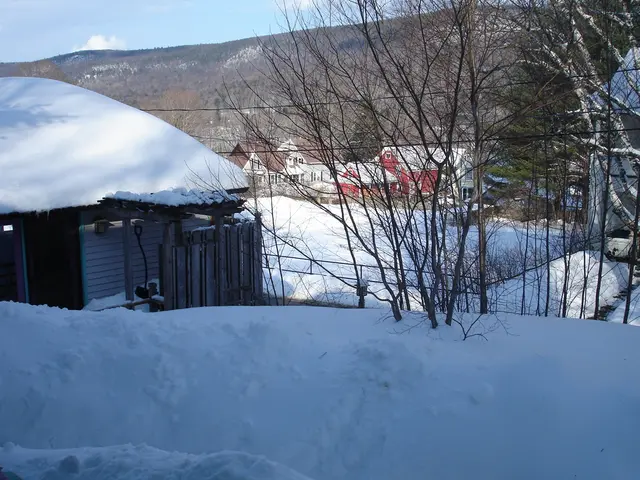Fireplace Disaster: Man Suffers Serious Injuries from Flash Fire
Last Sunday in Bottrop-Fuhlenbrock, a man found himself in a critical condition after a flash fire incident in his home's basement. As reported by the local fire department, the unfortunate accident occurred when the man attempted to ignite his coal stove by using ethanol. The ensuing flash fire resulted in severe injuries, prompting an emergency response and hospitalization at a specialized burn clinic.
To extinguish the embers and ventilate the space, the fire department intervened. A chimney sweep then assessed the integrity of the chimney, reinforcing the recommendation of the fire department against using accelerants when lighting stoves.
Let this case in Bottrop-Fuhlenbrock serve as a harsh reminder of the perilous consequences that can arise from improper usage of fireplace appliances. In North Rhine-Westphalia alone, the fire department tackles multiple chimney-related incidents every year, urging homeowners to obey safety guidelines.
Fireplace Safety: Proven Tips for Avoiding Mishaps
Save yourself from the deleterious consequences of flash fires and related accidents by adhering to these essential fireplace safety measures:
- Clean Out the Fireplace: Ensure the firebox is clear of cold ashes. Remove the ashes, keeping a few for fuel, but monitor your touch to avoid burning yourself.
- Inspect the Chimney: Check for cracks and repair them if necessary. Make sure your chimney cap is functional to keep out wildlife and debris.
- Use the Suitable Firewood: Burn seasoned hardwood such as oak, maple, or hickory. Avert using softwood like pine, as it increases creosote production. Opt for dry wood, storing it for six months or more in a high and dry location.
- Light the Fire Safely: Take advantage of kindling instead of flammable liquids to spark the fire. Position logs in the rear section to allow for adequate oxygen flow. Begin ignition from the top down for efficient combustion and limited creosote accumulation.
- Attend to Airflow: Ensure there are no drafts or hindrances that could impede airflow. Should your home be excessively sealed, partially opening a window can help facilitate necessary intake air.
- Employ Safety Barriers: Mandatory precautions include the utilization of a metal mesh screen or glass fireplace doors which bar hot embers from escaping and protect children and pets.
- Test Alarms Regularly: Frequently monitor and test your smoke and carbon monoxide detectors. Upgrade batteries annually and replace detectors every 10 years.
- Never Leave Unattended: Never leave a fire unattended, ensuring thorough cooling before ash disposal and proper use of a tightly sealed metal container with a lid for ashes storage.
- Properly Extinguish the Fire: Allow the fire to subside by spreading the embers. Apply ash on top, then thoroughly soak with water. Close the damper only after the ashes have completely cooled down to preclude carbon monoxide buildup.
By adhering to these guidelines, you can substantially reduce the likelihood of flash fires and related incidents when lighting your fireplace. Stay diligent with fireplace maintenance and use the correct techniques to protect your family and dwelling from harm.
Sources:
Enrichment Data: To instill fireplace safety and ensure that flash fires and incidents are averted, please obey these guidelines:
- Prepare the Fireplace:
- Remove Cold Ashes: Clear out the firebox of cold ashes, keeping a few for use. Ensure they are cool to the touch.
- Inspect for Cracks: Look for any cracks within the chimney. If necessary, hire a professional to repair them.
- Cap It: Ensure your chimney cap is intact to keep out animals and debris.
- Choose the Correct Wood:
- Burn Seasoned Hardwood: Opt for seasoned hardwood, e.g., oak, maple, or hickory.
- Dry Wood: Opt for dry wood stored for at least six months in a high and dry location.
- Light the Fire Properly:
- Rely on Kindling: Utilize kindling instead of explosive liquids to ignite the fire.
- Position Logs: Place logs in the rear to facilitate airflow.
- Start from the Top Down: Ignite the wood from the top down to promote efficient combustion.
- Control Airflow:
- Address Drafts: Eliminate any drafts or hindrances that could obstruct the airflow.
- Enhance Air Intake: If the home is overly sealed, partially open a window to facilitate air intake.
- Utilize Safety Barriers:
- Employ Metal Screen: Utilize a metal mesh screen to confine hot embers.
- Use Glass Fireplace Doors: Utilize glass fireplace doors to shield pets and children from harm.
- Monitor Alarms:
- Test Smoke and Carbon Monoxide Detectors: Regularly monitor and test your smoke and carbon monoxide detectors.
- Replace Detectors: Replace detectors every 10 years.
- Never Leave Unattended:
- Attend to the Fire: Never leave a fire unattended.
- Cool Ashes: Let the ashes cool down before disposal and ensure thorough cooling before storage in a tightly sealed metal container with a lid.
- Properly Extinguish the Fire:
- Allow the Fire to Subside: Allow the fire to gradually diminish before covering embers with ash.
- Sprinkle Water: Thoroughly wet the embers to ensure complete extinguishing.
- Close the Damper: Close the damper only when the ashes have completely cooled down.
By complying with these guidelines, you can significantly mitigate the risk of flash fires and related incidents when lighting your fireplace, safeguarding your family and residence from harm.








